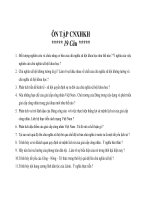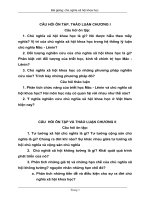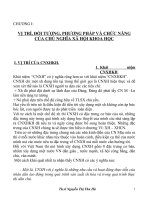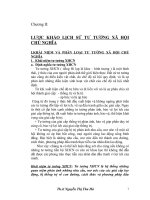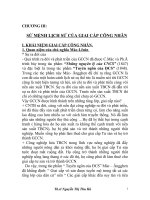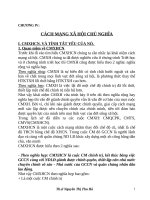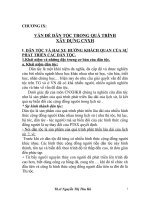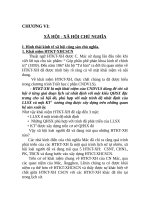Teaching ESL.doc
Bạn đang xem bản rút gọn của tài liệu. Xem và tải ngay bản đầy đủ của tài liệu tại đây (56.24 KB, 2 trang )
Teaching ESL/EFL Students to Write
Better
Yesim Cimcoz
A majority of students dislike writing. When faced with a writing task, most students will
react with comments like, "oh no not again" or "this is so boring". A teacher who does not
try to see the real message behind these comments could easily become discouraged.
Eventually, both the teacher and the students will 'hate writing'. To prevent this from
happening the teacher should consider what students actually mean when they say
"boring", and the possibility that students are actually expressing their insecurity and lack
of confidence in completing the task. Writing is a skill that has not been accorded the
attention it deserves in high school education. Students have not been taught to make their
ideas flow on paper. They don't know how to write, feel stupid when they can't find the
right words, fear criticism and want to avoid the emotional turmoil experienced when faced
with a topic and a blank piece of paper. Teachers who want to help their students gain
confidence in writing should try to follow a writing process that takes the student from
insecurity to success.
Coming to Terms with Reality
The first stage that students must go through is that of 'coming to terms with reality'. It is
very important that students be made aware of what their actual level of writing is at
present. It is also crucial that at this stage teachers must not tell students what they believe
their level to be but must provide the right feedback to enable students to see for
themselves. Students who do not write well should not be fooled into believing that they
do. At this stage, commenting only on the positive aspects of a student paper will only
create a false sense of confidence in the student. Comments on how to improve poor areas
in writing both on paper and in person can help students understand just what their writing
is in need of. Once this stage has been satisfactorily completed then the teacher must move
on to reassure students that it will be possible to improve their writing.
Reassurance
Reassurance is the stage where students are made to understand that poor writing is not a
curse, can be improved and most of all is not something for which they should punish
themselves. The message given by the teacher should be -- now we know what the problem
is let's deal with it! As you may notice, the teacher at this point is a crucial element in the
students' writing process because it is at this stage that the student needs an external
motivator.
Motivation
Motivation is probably the longest stage in this process. Tasks which allow students to
narrow down their expectations and move step by step toward the final goal of success, will
show them what they can do rather than what they can't. Each task should be set at a level
higher than the previous one, thus with each task students will build confidence and
become motivated to move on to the next step. Motivating students is somewhat like being
parents to a baby that has taken a first step. A first baby step brings with it claps and
screams of joy even though the step is not perfect. A positive reaction from parents will get
the baby to attempt another step, just as a positive reaction from the teacher will get
students to go a step further. Without realizing it with each step the student will gain
courage.
Once motivation has taken the student step by step toward higher achievement and self-
confidence, fear and insecurity will have been replaced with courage and students will feel
the need to show what they can do. Maintaining student courage at a specific level is very
important. If students have been pushed toward unattainable goals then they will have
gained a false sense of courage and their initial attempt at the final goal will bring
disappointment to both the teacher and the student. If all steps in the motivation stage were
attainable given the student's ability, then by the time students have reached the final goal
they will have the necessary courage to attempt writing that final essay.
The Initial Attempt at the Final Essay
Although the student has gained the courage to write, the initial attempt at the final essay
will be scary and some students may make mistakes. As a result of these mistakes, it is
possible for the student to revert back to fossilized methods previously learned. What the
teacher must look for at this stage are the good sentences scattered throughout the paper, an
easy flow of ideas or clear signs or organization. These positive aspects of the paper are
what must be stressed to the student and a comparison must be made between the initial
writing and the final essay to show where improvement is evident.
Success in writing for each student should be measured by individual realistic goals set at
the onset of the process. These goals should be attainable by the student given the student's
capacity to write. At this stage students should no longer be comparing their writing to
those of people who have a better grasp of the art. It is also important that students
understand that the level of writing they have achieved in English may not equal their
ability to write in a native language. With time and effort that may be the next goal for the
student to aim for.
Not everyone can become a writer. However, everyone can learn to write better and to
write, well organized, flowing essays with clear language. Focusing on grammar and
sentence structure is not the key to making better writers of our students. Students must be
given what any writer needs, an understanding of their capacity to write, motivation, self-
confidence and courage.

